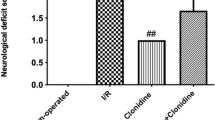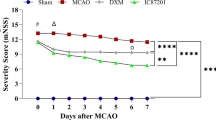Abstract
Objective: To observe and elucidate the neuroprotective effect of Xingnaojing (XNJ) injection on hippocampal N-methyl-D-aspartic acid (NMDA) receptors of focal cerebral ischemia in rats.Methods: Cerebral ischemia was established by occluding the middle cerebral artery with an intraluminal suture technique in rats. Neurological deficit score, infarct volume and quantity of NMDA receptors were estimated in all groups and compared.Results: After being treated with XNJ, the score decreased in the initial 6 hours and infarct volume decreased in 24 hours. And within 24 hours, the quantity of NMDA receptors obviously decreased compared with the model group (P<0. 01). It indicated that XNJ could ameliorate neurological behavior of middle cerebral artery occlusion rats and down-regulate the expression of hippocampal NMDA receptors.Conclusion: The neuroprotective effect of XNJ on focal cerebral ischemia is possibly related to down-regulating the expression of NMDA receptors in rats.
Similar content being viewed by others
References
Hickenbottom SL, Grotta J. Neuroprotective therapy. Semin Neurol 1998;18(4): 485–492.
Fisher M, Schaebitz W. An overview of acute stroke therapy: past, present, and future. Arch Intern Med 2000; 160(21): 3196–3206.
Zea-longa E, Weinstein PR, Carlson, et al. Reversible middle artery occlusion without craniectomy in rats. Stroke 1989; 20 (1): 84–91.
Zausinger S, Hungerhuber E, Baethmann A, et al. Neurologicalal impairment in rats after transient middle cerebral artery occlusions a comparative study under various treatment paradigms. Brain Res 2000; 863: 94–105.
Swanson RA, Morton MT, Tsao WG, et al. A semiautomated method for measuring brain infarct volume. J Cereb Blood Flow Metab 1990; 10: 290–293.
Waxham MN, Grotta TC, Silva AJ, et al. Ischemia-induced neuronal damage: a role for calcium/calmodulin-dependent protein kinase II. J Cereb Blood Flow Metab 1996; 16: 1–6.
Yoneda Y, Ogita K. Labeling of NMDA receptor channels by 3 H-MK801 in brain synaptic membranes treated with Triton X-100. Brain Res 1989; 499: 305–314.
Bowes MP, Rothlein R, Fagan SC, et al. Monoclonal antibodies preventing leukocyte activation reduce experimental neurological injury and enhance efficacy of thrombolytic therapy. Neurology 1995; 45(4): 815–819.
Ohtani K, Tanaka H, Yasuda H, et al. Blocking the glycinebinding site of NMDA receptors prevents the progression of ischemic pathology induced by bilateral carotid artery occlusion in spontaneously hypertensive rats. Brain Res 2000; 871(2): 311–318.
Fisher M. Neuroprotection of acute ischemic stroke: where are we? Neuroscientist 1999; 6: 392–401.
Author information
Authors and Affiliations
Corresponding author
Additional information
Provided financial assistance by “Hundred Talented Projects” of Shanghai Health Bureau (No. 97BR016)
Rights and permissions
About this article
Cite this article
Si-yu, S., Ding-fang, C., Wei-hua, C. et al. Effect of Xingnaojing injection on hippocampal N-methyl-D-aspartic acid receptors of focal cerebral ischemia in rats. Chin. J. Integr. Med. 9, 49–52 (2003). https://doi.org/10.1007/BF02836356
Received:
Issue Date:
DOI: https://doi.org/10.1007/BF02836356




